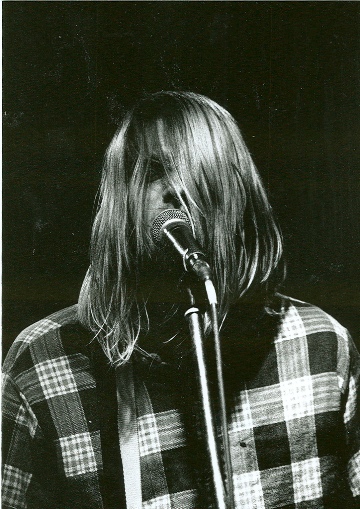
Photo soure: Guillaumelemay.tumblr.com
In November 1991, Nirvana played on all of our car stereos. We smoked clove cigarettes and drove through the Oakland hills with Nevermind blaring over the speakers. Kurt Cobain drowned out all the other sounds. “With the lights out, it’s less dangerous,” he yelled. Shrouded in fog and night, we agreed.
Grunge had traveled south from the damp Northwest, into Portland coffee shops, onto MTV and alternative radio stations, and into my high school. It wasn’t just music; it was a dress code: Kurt Cobain and Eddie Vedder wore thrift-store sweaters, waffle-knit long underwear, and plaid flannel shirts. We followed suit.
At fifteen, I raided my brother’s closet, stealing every plaid flannel I could find. I put them all on at once, mixed patterns and colors, donned men’s extra-larges like they were dresses. The shirt was a sign: it meant jeans with holes and cigarettes during lunch. It meant that somewhere inside you, in a place you could feel but couldn’t see, you were against it all: parents, school, “the system.”
Grunge is gone, but plaid is back. Mornings, I walk down San Francisco’s Second Street past throngs of tech workers in plaid button downs. Nights, I walk through the city’s Mission district, past wood-paneled bars awash in plaid, patterns and colors coalescing on torsos.
“Plaid has become unavoidable,” declares a recent Wall Street Journal story. “[S]tyle observers can’t recall a time when it was as popular with as wide a range of men.”
But plaid isn’t new — far from it.
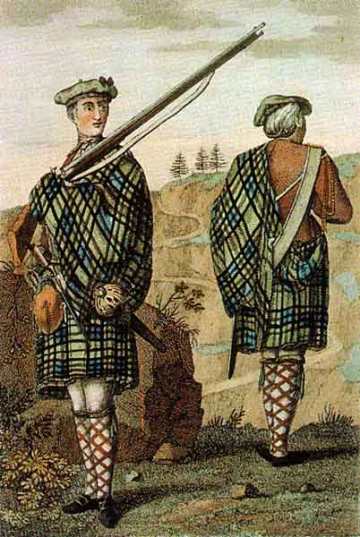
Private and corporal from a Highland regiment, circa 1744. Courtesy Wikipedia.org
The pattern has been worn in countries around the world since prehistoric times. It is often rightly associated with Scotland; we imagine bag pipers draped in plaid serenading green-hilled foggy mornings. Plaid was predominantly worn by those who lived in the mountainous Scottish Highlands; by the eighteenth century, particular patterns, or tartans, became associated with individual clans. After the Jacobite Uprising ended in 1745, the government went so far as to ban the wearing of tartan in an effort to suppress Highlanders’ regional identity. The pattern was no longer simply an item functional clothing, but was an expression of cultural and political affiliations (Robert Bain, The Clans and Tartans of Scotland; Iain Zaczek and Charles Phillips, The Complete Book of Tartan).
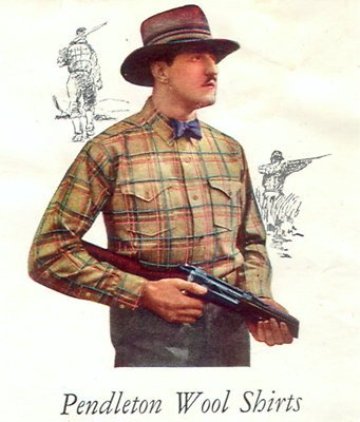
Vintage Pendleton ad. Courtesy Segui-riveted.blogspot.com
In the United States, plaid appeared most significantly in the form of the wool Pendleton shirt, introduced to the masses in 1924. Prior to its release, wool shirts were for outdoors work in the forests of the Northwest—they were drab and often gray. Pendleton added color and pattern, and their advertising emphasized hunting, masculinity, and outdoor labor—even if it was only suburban yard work.
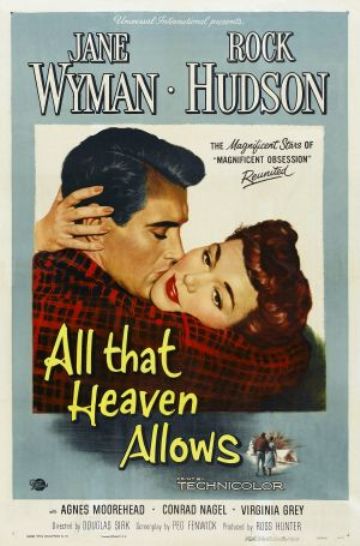
Courtesy Criterionreflections.blogspot.com
In the 1950s, as the United States became paved with parking lots and groomed landscapes, Pendleton plaid became a symbol of rusticity, an alternative to domestication. It’s no surprise that Rock Hudson wears plaid in his role as the rugged gardener in 1955’s All That Heaven Allows, romancing Jane Wyman away from the safety and stagnancy of her suburban home.
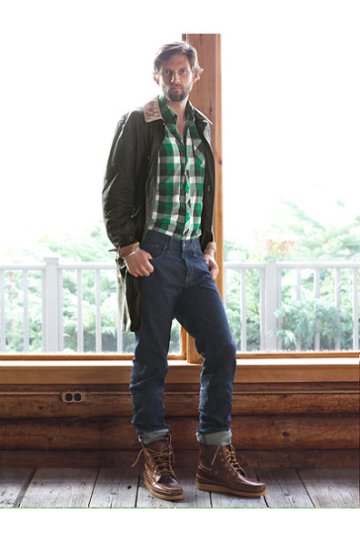
From L.L. Bean's heritage collection, spring 2011. Courtesy Llbean.com
Associated with nature and the outdoors, plaid is often presented in opposition to society and technological progress. Today, it is hawked as a centerpiece in the heritage fashion trend. Popular since 2007, heritage fashion champions long-standing American brands like Pendleton, Woolwich, and L.L. Bean. It equates such labels with quality and simplicity, taking us back to a time when clothes were American-made, the Western frontier beckoned, and life was simpler. As modern society becomes faster paced and increasingly virtual, plaid shirts and heritage fashion become gateways to a less globalized, less digital world.
But heritage fashion’s promise is hollow. As tech workers wearing plaid and carrying canvas rucksacks walk purposefully down city streets, far away from the open frontier, their fashion ceases to evoke a rustic lifestyle; instead it expresses a disconnection from and longing for that lifestyle. All we see is their striving, and the clothes take on the opposite of their intended meaning.
Plaid is often a pattern of contradiction, particularly when it used to assert one’s identity as an outsider. Alienated teenagers of the ’90s wore plaid flannel to communicate their isolation; in the process, they joined together, and their alienation was relieved. Today, DIY hipsters don thrift-store plaid in a statement of iconoclasm, in the process creating a culture of sartorial conformity. In both cases, one effect cancels out the other.
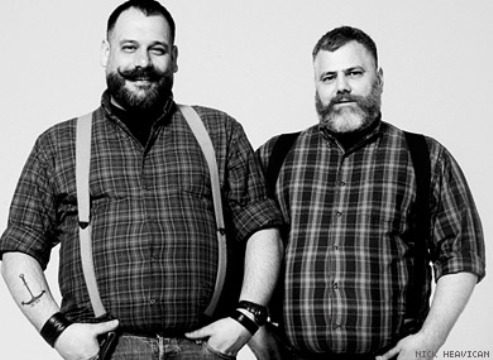
Clad in plaid, contemporary fashion designers Jeffrey Costello and Robert Tagliapietra are said to embody "bear chic." Courtesy Advocate.com
In the 1970s, plaid became a site of negotiation, enabling a partial collapse of a false dichotomy. It was during this period that many gay men adopted a hyper-masculine look, claiming traditionally heterosexual symbols and asserting their own manliness. “[G]ay men looked towards traditional images of rugged masculinity, such as the cowboy or lumberjack,” writes Shaun Cole in Don We Now Our Gay Apparel, his history of gay men’s dress in the twentieth century. “All these clothes had a clear meaning in the wider American culture: toughness, virility, aggression, strength, potency.” Two supposed polarities—homosexuality and heteronormative masculinity—unite in one fashion statement; both identities are destabilized in the process. Plaid continues to be prominent in gay male culture, having been coined “bear chic” in a 2009 article in the Advocate.
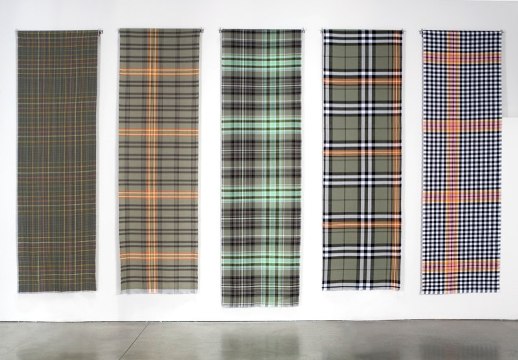
"Queer Plaids," by Jeremy Sanders. Courtesy the artist.
Jeremy Sanders is a textile artist who weaves cloth in his San Francisco apartment, using a loom the size of a baby grand. The young artist experiences synaesthesia, a condition that causes him to associate colors with letters and numbers. Using this personal system of meaning, he creates plaids whose colors “spell out” gay signifiers, words like fairy, fag, queen, and pansy. Playing with plaid’s ability to express and encode messages, the artist creates patterns whose meanings are both self-evident and invisible. Such a dynamic mimics the subversive forms of communication that are often necessary in oppressive societies.
In the next installment of Bedfellows, I interview Sanders about his coded tartans, their relationship to queer identity, and his recent projects.




